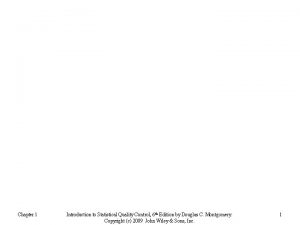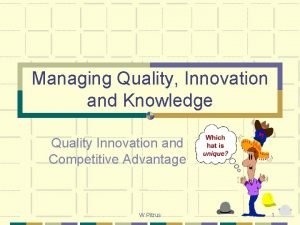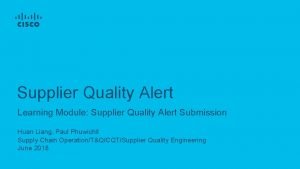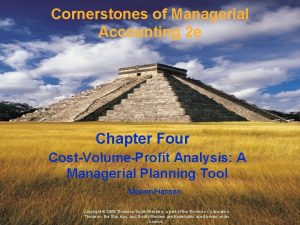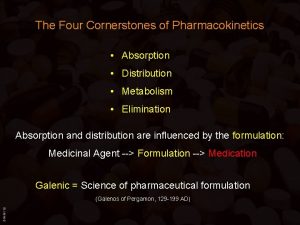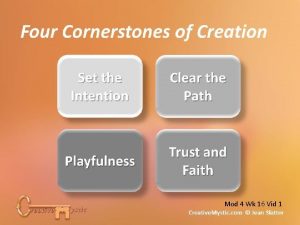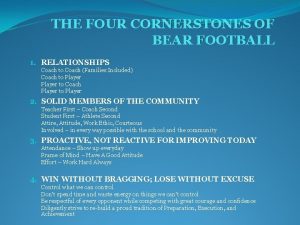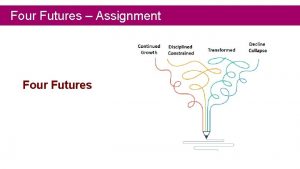Four Cornerstones of Quality 1 2 3 4




















- Slides: 20

Four Cornerstones of Quality: 1. 2. 3. 4. Quality in Design Quality in Course Management Quality in Content Quality in Online Preparedness

Cornerstone #1: Quality in Course Design v. Recognition that achieving Quality Matters (QM) recognition for a course is presently the gold standard in demonstrating quality online course design today. v. Beginning in the spring of 2018, it is our intention to begin a purposeful effort to submit at least the core courses (listed on the next slide) through QM external review by the end of 2020. v. Benefits: Provides a measure of quality assurance to our present and future stakeholders, as well as improve the actual quality of our courses. v. It will also likely have tangential effects with improving your face to face courses as well.

Our intended schedule is as follows: 2018 (Course Lead) 2019 (Course Lead) 2020 MGTK 301 (Angela Patrick) GBK 344 (TBD) MKTK 316 (Dalila Salazar) MGTK 302 (Rebecca Mc. Pherson) GBK 459 (Soo Jung Kim) MGTK 403 (YJ) GBK 301 (Jessica Robin) MGTK 350 (TBD) MGTK 406 (TBD) GBK 311 (Rick Simmons) MGTK 404 (Rebecca Mcpherson) GBK 434 (TBD) GBK 332 (Lucas Loafman) MGTK 405 (Amanda Eads) MKTK 508 (Tyson Ang) – OPEN Pending GBK 401 (Barb Altman/Jessica MGTK 425 (Barb Altman) Robin) GBK 588 (Vivien Jancenelle) MKTK 301 (Kay Carey) MGTK 421 (Vinay Gonela) MGTK 501 (Team) – OPEN Pending GBK 510 (Monica Wei)

Cornerstone #2: Quality in Course Management v. Generally, the easiest one for faculty to excel in and has a tremendous impact on student satisfaction. v. This concept is akin to a discussion in our Strategic Management text on Lexus Service. Ø In surveys, Lexus found in one case that their service was so impeccable that the customer really never stopped to think that they had to return four times to complete a relatively simple repair. Ø The same can be true in classes. High levels of responsiveness and concern about the student can overcome other negative issues that might arise in course. v. As a new university, we have largely our word of mouth reputation to live on, thus the experience must be a positive one. v. The theme from literature is that the instructor must be “present” and active in the course, as well as responsive to student needs. Ø This does not mean give in to any request however. Ø We must communicate on assignments and questions in a timely and constructive manner, so that the student is placed in the best position possible to be able to succeed.

To achieve a reasonable level of responsiveness to students, we pledge to do the following: 1. Communicate with student inquiries in a timely fashion. What does timely mean? The most common response found during a recent literature review was that students expected a response to their email questions within 24 hours. While many faculty do check email seven days a week and in between terms, we recognize that personal and/or religious reasons may limit one’s availability during certain periods.

Email Communication a. First, it is important that email communication expectations must be clearly stated to students. b. Second, it is vital that when we state it, we live by it or be prepared to let students know why we may not be able to be available or respond as intended. ØWhile responding to student inquiries within 24 hours is our goal, we pledge ourselves to check and respond to student emails a minimum of 5 days a week. ØIf the answer to a question is not known presently, then we must at least acknowledge the receipt of the message and let the student know that we are working on it.

Email Communication continued: ØThe days and general times that we will respond will be stated in our syllabi and posted on Canvas. ØIf we do not intend to check email on Saturday or Sunday, two of our times (remember a minimum of 5) should be no earlier than late Friday afternoon and first thing Monday morning. § Even this window makes responses around 60 hours after the time a student may have sent a communication. ØAlso, we should not schedule assignments to be due over the weekend if we do not intend to be available to answer questions about submissions or fix glitches in the set-up of the assignment.

Email Communication continued: ØOur office and/or cell phones may be used as an alternative mode of communicating with students. § Again, the same basic principles should apply. § If we state availability, we must be available and responsive or inform students about unavailability. ØMost likely our office phone response time will mirror our office hours, but that should be clearly stated in the syllabus as well. § If we’re only in the office two days a week for phone calls, we need to be responding to email at least three other days at a minimum. ØWe should be diligent about checking our messages and clearing our voice mailbox. ØWe should not have students unable to reach us because our voice mailbox is full.

Pledge to: 2. Communicate with Students in a Constructive and Professional Manner. v. We are here to help the students meet the course and program objectives. v. As such, our communications with students should provide information that sufficiently answers their questions so that they can be successful. v. Though there will be times when the communication from students is vague or outright unprofessional, our responses should be respectful and try to either clarify what information we need to answer their questions and/or coach them on proper professional decorum in communications.

Pledge to: 3. Provide Assignment Feedback in a Timely Manner. v. If we remember back to when we were in school, there were at least some points in time where we were very concerned, or outright nervous, about pending grades. v. Our students today are no different. Ø Thus, we will strive to grade assignments in a timely manner that respects both the students and the faculty. Ø In doing so, there are four guidelines that should be utilized.

Four Guidelines for Providing Feedback 1. Lower Stakes Assignments (Less than 10% of the course grade) – Within 72 hours after due date. 2. Higher Stakes Assignments (More than 10% of the course grade) – No more than one week after the due date. 3. Exams (Mostly Objective) – Within 72 hours after due date. 4. Exams (Lengthy Case/Essay) – No more than one week after the due date.

Grading Timelines ØGrading timelines should be stated in the syllabus and the timelines may need to shorten if the assignment is repetitive and the feedback from one assignment will aid the student in completing the next one or if it is an eight week course. Ø To facilitate our ability to meet these timelines, we should plan all of our courses such that due dates are spread out. ØAlso, if these timelines are not realistic, there is also the possibility that we may have too many assignments due. ØIn the event that it appears that we might not be able to meet our grading timeline guidance, it is vital that we communicate that information with students as soon as possible, as our timely communication can work to reduce the level of dissatisfaction with our grading timelines not being met.

Pledge to: v. The circumstances are rare where only providing a number grade is sufficient feedback for the student. 4. Provide Assignment Feedback in a Constructive Manner. ØSome examples include an assignment that is purely objective, incredibly low stakes, the purpose of the assignment is based on participation rather than what was actually said, or the student actually exhibited true mastery. ØOtherwise, we owe it to our students to provide a sufficient level of feedback such that they can learn and improve, as that’s what they’re here for. v. Again, this is especially important if the assignment is repetitive or progressive. ØThe level of feedback sufficiency is subjective and the relative weight and importance of the assignment should be considered.

Pledge #4 continued: v. Incredibly detailed feedback early in the term will hopefully lessen the need for detailed feedback as the course goes on. v. In providing feedback, consider not just if your comment makes sense to you, but if it would truly make sense to a third party reading. v. Remember that we’re experts in our disciplines and our students are not.

Cornerstone #3: Quality in Course Content v. Whether our students are face to face or online, we will strive to provide as an equivalent of an instructional experience as possible. v. Obviously, there are certain limitations that the online modality creates, but we must strive for creativity in taking the face to face classroom experience to the online one. v. We recognize that our resources are limited in terms of time, support, and money to create the type of experience we might want, but it is within our power to provide sufficient quality content to help the students meet the course objectives.

Cornerstone #3 continued: ØOne of the big issues to consider in looking at one’s online course content is “contact hour” equivalence. ØBasically, do your online students have at least forty hours of instructional time, just as your face to face students do? ØThough some institutions have begun counting equivalent content under an institutional wide measurement of equivalence, we intend to leave it to the instructor to be able to demonstrate that they have content and instructional activities that equate to approximately forty hours. ØTo the right is a non-exhaustive list of the type of activities that count towards the forty hour guideline: üReasonable Exam Time. üListening to Audio Lectures or Watching Videos. üDiscussions. üInteractive Journals. üReadings/comparable activities that would occur in the face to face classroom.

Cornerstone #3 continued: ØThe following non-exhaustive short list contains types of activities that do not count towards the forty hour guideline: üReading the text. üWorking on homework assignments or projects that are usually done outside of class in a face to face environment.

Five Hours of “US” ØThere must also be a significant component of “us” in each course. ØWhile it is true that some of the publisher resources and other readings and videos found online are great teaching tools, students should also expect to hear from our faculty. ØWe were hired because we have stories, experiences, and knowledge to share. ØTo this end, we should target at least five hours of “us” in each course. This will likely come from prepared videos, audio messages, notes, and other explanatory activities. Ø “Us” does not have to mean “you. ” ØWe have many courses where multiple instructors contributed to the “us” factor. v. All online courses are expected to meet these standards by the Fall of 2018. v. All online courses should be able demonstrate 30 hours of content and 2. 5 hours of “us” content by the Fall of 2017.

Cornerstone #4: Instructor Preparation v. In order to be an effective online instructor, we need to be comfortable and competent on the technologies we currently utilize, as well as continue to stay abreast of those emerging technologies. v. These new technologies may improve the educational experience for our students and support our goal of continuous improvement. v. Though the university is about to come out with its own annual minimum training requirements for online instructors, we pledge to try to do more than the minimum. Ø As such, faculty who teach at least one course per semester online should participate in at least 25% more training and education related to online teaching and/or technology each year than the university minimum. Ø This can be accomplished in multiple ways, including conferences, QM courses, university hosted opportunities, and even documentable self-study. v. Remember this would help with your teaching evaluation piece.

Issues/Lessons Learned • Not as easy as I thought – Took 18 months to “implement” and had to back off of several items (timeline and content) • Managing the message – Battle for time and resources • Will it last?
 Identify the cornerstones of the wellness movement
Identify the cornerstones of the wellness movement Cornerstones of cost accounting
Cornerstones of cost accounting Old quality vs new quality
Old quality vs new quality Project quality management pmp
Project quality management pmp Quality control basics
Quality control basics Pmbok quality management
Pmbok quality management Quality gurus and their contribution
Quality gurus and their contribution Ana quality assurance model
Ana quality assurance model Crosby quality is free
Crosby quality is free Perform quality assurance
Perform quality assurance Compliance vs quality
Compliance vs quality Four sides and four corners
Four sides and four corners 4 eyes skin assessment tool
4 eyes skin assessment tool Project quality management pmp
Project quality management pmp Introduction to statistical quality control
Introduction to statistical quality control Focus quality innovation
Focus quality innovation Foqa aviation
Foqa aviation Quality circle structure
Quality circle structure Total quality management assignment
Total quality management assignment Soil horizon foldable
Soil horizon foldable Quality alert form
Quality alert form














